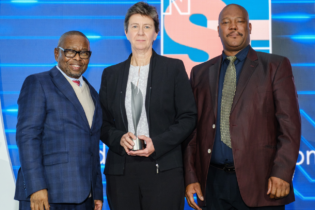A loan scheme and methodological guidelines adopted at this year’s African Carbon Forum in Addis Ababa are looking to smooth Africa’s entry into carbon markets, with East Africa set to play a leading role.
The move is designed to allow more African countries to adopt the Clean Development Mechanism (CDM), introduced by the United Nations Framework Convention on Climate Change (UNFCCC), which involves implementing emissions reductions projects and earning sellable carbon credits. This has been adopted by many developing countries, but so far Africa has been lagging behind as a result of the lack of methodology. Of the registered 3 927 CDM projects across the world, only 84, just over two per cent, are in Africa. East Africa seems to be the preferred destination for carbon investors, offering real opportunities to renewable energy businesses in the region. Seven of the nineteen carbon sequestration projects in Africa are based in Kenya, Uganda and Tanzania. Carbon credits have become big business, with richer countries offsetting their pollution by paying developing economies to launch clean and renewable energy projects, as well as planting trees. Tackling climate change, it can also be of economic benefit to developing nations. The World Bank says that the carbon market can earn poorer nations more than $25 billion every year. Numerous companies also have the potential to earn carbon credits through reducing their emissions. Companies who deal with cooking stoves, domestic biogas and green charcoal can earn credits, as can those involved with small-scale hydroelectricity, LED lighting, solar water heaters and water purification and industrial companies in the cement, biodiesel and sugar sectors. Some firms are taking advantage of this. Kenyan firm East African Portland Cement began a project in 2010 that would enable it to sell carbon emissions for $1.7 million annually, while KenGen and Mumias Sugar Company are also engaged in carbon trading. Yet in general uptake in Africa has been limited. The low global carbon price may have contributed in making entering carbon markets less attractive to African countries. Prior to the financial crisis projections that the price of a carbon credit would range from €30-€40 per ton of emissions by 2030, yet the crisis means that carbon credits are currently worth about €4 per ton. Lack of methodologies was also holding African factories back, according to Ambachew Fekadeneh, a member of the CDM Methodology Panel under UNFCCC. “The introduction of the standardised methodology will help such factories to measure their emissions reductions,” he said. “When they know the amount of emissions that they reduced, they can participate in the carbon market.” The cost of setting up the required infrastructure was also debilitating, hence the decision to introduce the loan scheme. Developers will be able to use the loans to build up their projects before demonstrating their ideas to investors and carbon credit buyers. Carbon trading is, however, a growing market, with Thomson Reuters Point Carbon reporting in January that the global market was worth €96 billion, with approximately 8.4 billion tonnes of carbon dioxide traded in 2011. This represents a 4% increase in value from the previous year and a nineteen per cent increase in traded carbon dioxide. East African governments are leading the way in Africa in seeking to develop their infrastructure in order to enter the global carbon market. The Ethiopian government plans to invest $150 billion over the next twenty years, raising funds from the International Climate Fund and carbon markets. The country is also launching Africa’s first ever large-scale forestry project, the Humbo Assisted Natural Regeneration Project, which plans to cut an estimated 880 000 metric tonnes of carbon dioxide from the atmosphere over the next thirty years. The local community is predicted to benefit to the tune of $700 000 through the sale of carbon credits. Uganda has obtained $2.6 million in funding from the Belgian Development Agency as it looks to become a CDM hub over the next three years. Tanzania’s government is preparing a National Climate Change Strategy and Action Plan which involves strategies on how to take advantage of the carbon market. Carbon sequestration projects are hugely relevant to African countries that need increased investment to alleviate poverty and build their infrastructure.The United Nations Environmental Programme (UNEP) last year launched a scheme with the World Agroforestry Centre to calculate how much carbon trees and soils actually absorb. “Managing the land and its vegetation in more intelligent and climate-friendly ways may generate multiple benefits from stabilizing soils, securing water supplies, conserving biodiversity and generating much needed income for poor and low-income communities,” said UNEP boss Achim Steiner, estimating that selling 100 million carbon credits would earn African economies an estimated $1.2 billion each year. He added that the challenge was to make sure that such opportunities were available to everyone.
This challenge is being take up by other groups. Kenyan farmers are gradually gaining the opportunity to take advantage of the carbon industry. More than 48 000 are selling carbon credits in the United States through The International Small Group and Tree Planting Programme (Tist), while the World Bank’s Carbon Finance Unit’s BioCarbon Fund, in partnership with the Swedish non-government organisation Vi Agroforestry, has had a new soil carbon methodology approved by the Verified Carbon Standard. The methodology helps farmers adopt practices that build up the soil’s organic matter, increasing its resilience to climate change effects and helping to store more carbon in the ground. It will allow farmers to earn carbon credits. Some of the practices included in the methodology are crop residual management, manure management, use of cover crops and the introduction of trees to the landscape. “Project farmers are increasing soil carbon and organic matter through mulching, cover crops, manure and plant waste management” in order to combat erosion and enrich degraded soil, said Bo Lager, Programme Director at Vi Agroforestry. “Carbon finance has the potential to leverage climate smart agriculture. The methodology is very generic which means it can be scaled up to various agro-ecological regions in Africa.” The methodology helps increase farm yields and incomes, while further techniques such as reducing ploughing also reduce the release of carbon dioxide. “Smallholders can earn carbon credits for that,” says Lager. “Carbon finance helps make the project financially sustainable.” In the past carbon finance has not been employed for rural development, but experts agree that soil carbon has the potential to be of great importance to soil fertility and sustainable agriculture in rural Africa. It also provides a link between these and climate change mitigation on the continent. “These farmers have adopted new farming techniques and as a result are benefiting from a triple win in agriculture,” said Andrew Steer, the World Bank’s Special Envoy on Climate Change during a visit to one of the divisions in Kisumu. “They are getting higher yields, improving the resilience of their crops to drought and creating stronger soils that sequester more carbon.” The BioCarbon Fund plans to roll out the methodology across the whole of developing Africa, having already had 38 such methodologies approved. The new regulations are likely to make it easier for CDM projects to take off in Africa. They will benefit from 2013 from privileged access to the EU Emissions Trading System (ETS), with market observers expecting richer African nations to agree deals with the EU. “European compliance buyers, development banks, government buyers – they all want African credits,” says Geoff Sinclair, the London-based head of carbon markets sales and trading at Standard Bank. “There is no lack of demand. There is, however, a shortage of supply.” The bank is assisting in funding start-up developers and consultancies so African countries have experts on the ground. There is a feeling that, with projects already in place and further assistance to come for further developments, Africa is the next big theatre for carbon finance. Rob Kelly, a senior technical advisor with the UN Development Programme (UNDP), thinks the spread of carbon finance in Africa is just a matter of time after the scheme took off in more-developed Asia. “The low-hanging fruit [in Asia] was reached first, and Africa is now in the second wave.”Source: ventures-africa.com








